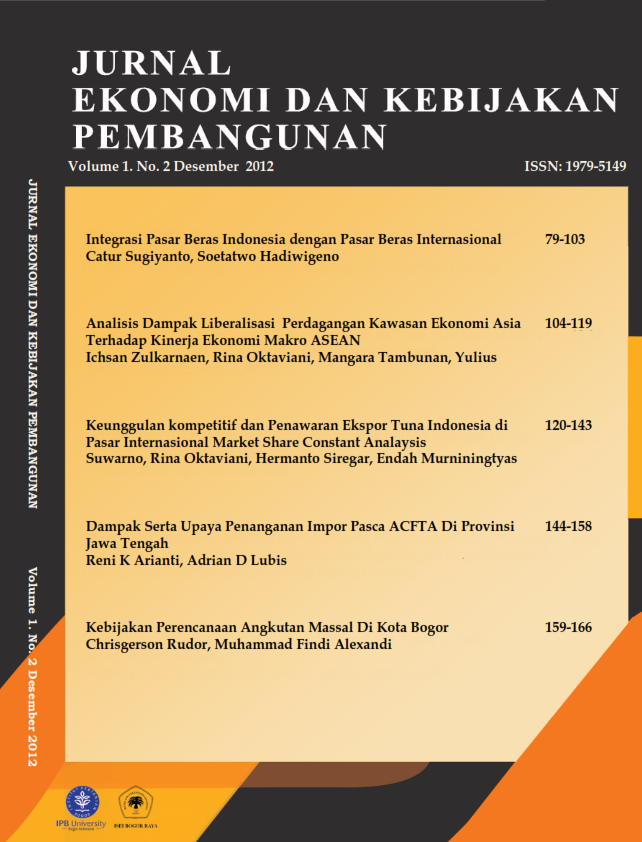Abstract
Density and population of bogor that keeps increasing will add the duty of government to provide more public means of mass. Transportation is a vital public facility. Public transport available in Bogor is a city transportation (public transportation) and buses. The existence of a number of public transportation totaling 3,412 units and 30 units of bus has been able to serve the needs of the community in transportation, but in terms of efficiency and comfort are still far from expected.
Based on the results of Stated Preference regression models, we concluded that the most efficient mass transportation is city buses, and the most variable priority attribute passengers on a city bus is the bus occupancy, the bus waiting time efficiency, got a seat, bus convenience and cost/ bus rates. So the recommendation that we can give, the problem due to public transport in bogor can be solved by the means of mass transportation such as city buses.
Keywords: Density and population of Bogor, PublicTtransportation, Stated Preference Models
References
Antara. 2011. Atasi Kemacetan, DLLAJ Kota Bogor Kurangi Jumlah Angkot. http://bisnisjabar.com/index.php/2011/09/atasikemacetan-DLLAJ-kota-Bogor kurangi-jumlah-angkot/ (diakses tanggal 28 September 2011).
Arsyad, L. 1999. Ekonomi Pembangunan. STIE. Yayasan Keluarga Pahlawan, Yogyakarta.
Glasson, J. 1977. Pengantar Perencanaan Regional (Bagian Satu dan Dua). Paul Sitohang [penerjemah](1990). Lembaga Penerbit FE-UI, Jakarta.
Jhingan, M. L. 2004. Ekonomi Pembangunan dan Perencanaan. PT. Raja Grafindo Persada, Jakarta.
Kuncoro, Mudrajad. 2003. Ekonomi Pembangunan Teori, Masalah, dan Kebijakan. APP AMP YPKN, Yogyakarta.
Mangkoesoebroto G. 2009. Ekonomi Publik. Yogyakarta: BPFE Yogyakarta.
MHM Amirotul, Agustin T, W S Hastuti. 2006. Analisis Variabel Layanan angkutan Umum Bus Kota Menurut Persepsi Penumpang Dengan Teknik Stated Preference (Studi Kasus Angkutan Umum Bus Kota di Surakarta). Media Teknik Sipil. Universitas Sebelas Maret: Fakultas Teknik. Hlm 55-60
Pemerintah Kota Bogor. 2011. Seluruhnya Ada 3.412 Unit Angkot Beroperasi di Kota Bogor.
http://kotabogor.go.id/index.php?o ption=com_content&task=view&id =7596 (diakses tanggal 28 September 2011).
Priyarsono, D.S., Sahara, dan M. Firdaus. 2007. Ekonomi Regional. Universitas Terbuka, Jakarta.
Subandi. 2008. Ekonomi Pembangunan. Alfabeta, Bandung.
Tarigan R. 2005. Ekonomi Regional: Teori dan Aplikasi. Jakarta: Bumi Aksara.
Wahyuningtias E. 2008. Kemacetan di Pusat Kota Bogor [Skripsi]. Depok : FMIPA Universitas Indonesia.
World Bank. 1996. Sustainable Transport: Priorities for Policy Reform. Development in Practice Series.Washington, DC: World Bank.
Authors

This work is licensed under a Creative Commons Attribution-NonCommercial-ShareAlike 4.0 International License.
The authors who publis article(s) in Jurnal Ekonomi and Kebijakan Pembangunan have to understand and agree that the copyright of article published is owned by Jurnal ekonomi and Kebijakan pembangunan including to reproduce, distribute and sell this journal to public.

